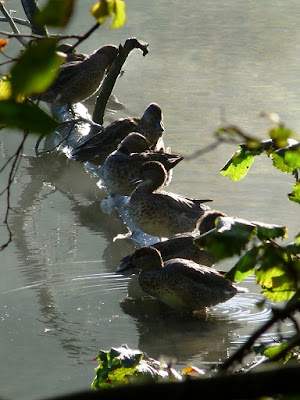No rainbows today but I did manage to connect with the pot of gold that remained hidden last time; a group of Dotterels!
Numbers in this particular field in Flemish Brabant had been building up to a maximum count of 34 during the rainy weather of the past few days but today was my first chance to go there. It also happened to be the first morning with clear skies so I was worried they may have left on the next step of their migration before I got there. Sure enough, I arrived at the location to see no other birders at all, which is not a good sign. Still, I began scanning and rescanning and turned up four Wheatears but nothing else. I thus decided to to do a big loop of the field and eventually saw several other birders, none of whom stopped for more than five minutes. The signs were not good at all. I even convinced myself I heard them at one point but the faint calls were actually coming from an extremely distant parakeet in the nearest village! Furthermore, the loop turned out to be a lot longer than I expected, taking me well away from the original spot so that, after an hour and a half of searching, I'd still not even circumnavigated the entire field but had already given up and decided to head home. Just as I sped up, however, I caught a movement of something running in the field out of the corner of my eye, and got on it straight away to find a Dotterel, then another, then another! After a quick scan, I'd first counted eight, but then I looked up the slope and found more; now there were 16 of them. At this point, several Skylarks flew up from my feet so I briefly took
my eyes of the Dotterels but then looked back only to find they had
gone. I was sure they hadn't flown off as I thought I would have noticed that
but they were nowhere to be seen despite repeated scans of the same
area. I stayed put, though, hearing a Tawny Pipit, a scarce migrant in Belgium, passing over, and getting a good view of this juvenile Hen Harrier. The
photo isn't great but it does show the typical bulging arm and
five-fingered wingtip which help differentiate this species from the
other harriers in flight.

Suddenly, after half an hour, the Dotterels were there again, all sixteen of them, in exactly the
same spot! I was starting to believe Dotterels used the same
teleporters that antpittas use in the Amazon to move around the forest
without being seen when the mystery unravelled itself. One by one, the
birds crouched down, blending in so well with the mud and stubble, that
they disappeared before my very eyes. I knew where they were and was
looking right at them but I could no longer see them. Now that is what I
call camouflage! I waited another ten minutes or so, but again, they
remained invisible as they weren't moving, so I left them to it, very
pleased at having located them and adding another species to my Belgian
list. None of the other birders even bothered to check that end of the
field as they'd not been seen there before so I was the only one to see
them today. Here is a very heavily cropped photo of two of them; for some real Dotterel pictures, have a look at
these taken by a Polish birder last week.


















































